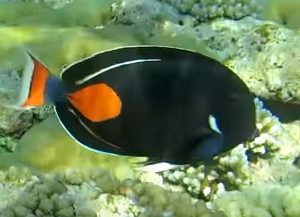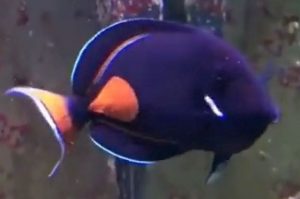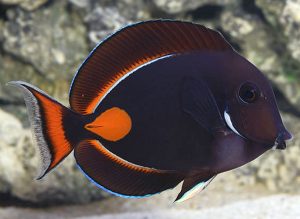The Achilles Tang (Acanthurus achilles) known to tropical fish keeping enthusiasts as Achilles Surgeonfish, Red Spot Surgeonfish, and Red Tail Surgeonfish, is found in the Western Pacific around the islands of Oceania, the Pitcairn Islands, the Hawaiian Islands, the reefs surrounding the Islands of Marcus, Mariana, and Wake; and in the Eastern Central Pacific, around Baja California and Mexico.
Achilles Tangs are usually encountered alone or in small pods in the surge zones of the near seaward reefs of their range at depths from 12 to about 35 feet where they feed on benthic filamentous and fleshy algae among the corals. They thrive in highly turbulent waters with strong currents and highly oxygenated water conditions, typical of tidal surge zones.
Adult Achilles Tangs have a black, or dark brown to purplish body color, with bright highlights of white and orange around the dorsal, caudal, and anal fins. A bright white “comma” marking is present on the gill covers. Adults develop a prominent, orange colored, horizontal shaped tear drop on the caudal peduncle, that terminates into a sharp spine which is believed to be venomous.
In juveniles, the prominent orange teardrop shaped mark starts out as a streak that gradually changes shape over time as the fish matures. Males and females have no obvious visual sexual differences. In the wild, Acanthurus achilles sometimes hybridize with Acanthurus nigricans.
The Achilles Tang is best housed in a FOWLR or reef tank of at least 180 gallon capacity with a crushed coral or sandy substrate, good amounts of mature live rock arranged into caves, crevices, and overhangs for them to graze and hide among, and plenty of free swimming space. Achilles Tangs are completely reef safe and will not disturb corals, ornamental clams, or invertebrates. They are constant grazers that requires a well established tank with healthy growths of marine algae.
They require strong currents and highly oxygenated water to thrive, therefore, a series of power heads along with a good reef filtration system is recommended to keep this species healthy. Because they are very sensitive to ammonia poisoning, pristine water conditions are mandatory.
Achilles Tangs can be extremely aggressive toward conspecifics and most other surgeonfish, especially in smaller tanks and as adults. They are best kept alone in a lightly stocked reef tank with smaller, more docile species found in the tidal zones. To keep the Achilles Tang parasite free, it’s a good idea to keep a cleaner shrimp and/or a cleaner goby in the same aquarium. The Skunk Cleaner Shrimp (Lysmata amboinensis) and Blue Neon Cleaner Goby (Elacatinus oceanops) are good choices.
Breeding the Achilles Tang in an aquarium environment is virtually impossible. They are open water egg scatters that spawn in small to medium size groups. The females rise toward the surface where they eject a cloud of tiny eggs. The male immediately follows the female to swim through the cloud and fertilize the eggs. The fertilized eggs have a minute droplet of oil in them that allows them to float on the surface until they hatch out into small larvae. The larvae feed on plankton until they develop into juveniles and join the reef population. The size of metamorphosis from post larva stage to juvenile is about 2.6 inches.
The Achilles Tang is a herbivore that in their natural environment feed primarily on benthic algae. In an aquarium environment, they are often picky eaters and may not readily accept any foods offered. They will eat meaty foods fed to other fish in the aquarium, but it is extremely important that they are offered plenty of marine based seaweed and algae to strengthen their immune system, reduce aggression, and improve their overall health. Dried seaweed (Nori) tied to a rock or placed in a veggie clip should be fed at least 3 times per week along with their regular feeding schedule. Sea Veggies
, Seaweed Salad, and Ocean Nutrition are all easy to use products that will keep them healthy.
The Achilles Tang (Acanthurus achilles) is an extremely difficult species to care for properly. In addition to being picky eaters, they seem to develop ich, lateral line, and hole in the head disease at the slightest justification. This being said, they are available to tropical fish keeping enthusiasts from specialty fish shops and online wholesalers, retailers, and collectors at the following approximate purchase sizes: Juvenile Small: 2″ to 3″; Medium: 3″ to 4″; Juvenile/Young Adult, Large: 3″ to 4″; Adult Small: 3″ to 3-1/2″; Small/Medium: 3-1/2″ to 4″; Medium: 4″ to 4-1/2″; Medium/Large: 4-1/2″ to 5″; Large: 5″ to 6″; X-Large: 6″ to 7-1/2″. Depending on size and area of collection, they range in price from $399.99 for a small/medium to over $750.00 for 6″ specimens.
Because the Achilles Tang (Acanthurus achilles) has become somewhat rare in the hobby and difficult to acquire, it is best to see this fish eat before you purchase one for your aquarium.
Minimum Tank Size: 180 gallons
Aquarium Type: Reef or FOLR
Care Level: Difficult
Temperament: Semi Aggressive
Aquarium Hardiness: Hardy
Water Conditions: 72-78° F, dKH 8-12, pH 8.1-8.4, sg 1.020-1.025
Max. Size: 9″
Color Form: Black, Purple, Orange, White
Diet: Herbivore
Compatibility: Reef Ok
Origin: Eastern and Western Pacific Ocean, Hawaii
Family: Acanthuridae
Lifespan: Over 7 years
Aquarist Experience Level: Expert Only





